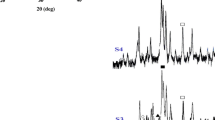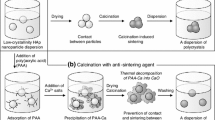Abstract
A polymeric sol–gel combustion method has been used to synthesize nanocrystalline hydroxyapatite (HA) powder from calcium nitrate and triethyl phosphate with the addition of NH4OH. The sol–gel combustion process generates phase-pure nanocrystalline HA powder, as characterized using Fourier transform infrared (FTIR), X-ray diffraction (XRD), and transmission electron microscopy (TEM). Sintering of the HA powder compact at 1200°C for 2 h leads to a 93% theoretical dense ceramic body. This method offers an easy route for the preparation of phase-pure nanocrystalline HA powder.






Similar content being viewed by others
References
M. Jarcho, C.H. Bolen, M.B. Thomas, J. Bobick, J.F. Kay, R.H. Doremus, Hydroxylapatite synthesis and characterization in dense polycrystalline form. J. Mater. Sci. 11, 2027–2035 (1976). doi:10.1007/BF02403350
T. Ishikawa, H. Tanaka, A. Yasukawa, K. Kandori, Modification of calcium hydroxyapatite using ethyl phosphates. J. Mater. Chem. 5, 1963–1967 (1995). doi:10.1039/jm9950501963
K. Kandori, A. Yasukawa, T. Ishikawa, Preparation and characterization of spherical calcium hydroxyapatite. Chem. Mater. 7, 26–32 (1995). doi:10.1021/cm00049a007
J. Wang, L. Shaw, Morphology-enhanced low-temperature sintering of nanocrystalline hydroxyapatite. Adv. Mater. 19, 2364–2369 (2007). doi:10.1002/adma.200602333
T. Hattori, Y. Lwadate, Hydrothermal preparation of calcium hydroxyapatite powders. J. Am. Ceram. Soc. 73, 1803–1805 (1990). doi:10.1111/j.1151-2916.1990.tb09841.x
J. Liu, X. Ye, H. Wang, M. Zhu, B. Wang, H. Yan, The influence of pH and temperature on the morphology of hydroxyapatite synthesized by hydrothermal method. Ceram. Int. 29, 629–633 (2003). doi:10.1016/S0272-8842(02)00210-9
Y. Fujishiro, H. Yabuki, K. Kawamura, T. Sato, A. Okuwaki, Preparation of needle-like hydroxyapatite by homogeneous precipitation under hydrothermal conditions. J. Chem. Technol. Biotechnol. 57(4), 349–353 (1993)
M.-F. Hsieh, L.-H. Perng, T.-S. Chin, H.-G. Perng, Phase purity of sol–gel-derived hydroxyapatite ceramic. Biomaterials 22, 2601–2607 (2001). doi:10.1016/S0142-9612(00)00448-8
H.K. Varma, S.N. Kalkurab, R. Sivakumaf, Polymeric precursor route for the preparation of calcium phosphate compounds. Ceram. Int. 24, 467–470 (1998). doi:10.1016/S0272-8842(97)00038-2
Y. Han, S. Li, X. Wang, X. Chen, Synthesis and sintering of nanocrystalline hydroxyapatite powders by citric acid sol–gel combustion method. Mater. Res. Bull. 39, 25–32 (2004). doi:10.1016/j.materresbull.2003.09.022
W. Weng, J.L. Baptista, Synthesis of calcium phosphates by PO(OH)x(OBut)3−x and CaO2C2H4. J. Sol–Gel. Sci. Technol. (Paris) 8, 645–649 (1997)
D.-M. Liu, T. Troczynski, W.J. Tseng, Aging effect on the phase evolution of water-based sol–gel hydroxyapatite. Biomaterials 23, 1227–1236 (2002). doi:10.1016/S0142-9612(01)00242-3
H.-W. Kim, H.-E. Kim, J.C. Knowles, Improvement of hydroxyapatite sol–gel coating on titanium with ammonium hydroxide addition. J. Am. Ceram. Soc. 88, 154–159 (2005)
Y. Li, W. Weng, K.C. Tam, Novel highly biodegradable biphasic tricalcium phosphates composed of α-tricalcium phosphate and β-tricalcium phosphate. Acta Biomater. 3, 251–254 (2007). doi:10.1016/j.actbio.2006.07.003
H.P. Klug, L.E. Alexander, X-ray diffraction procedures for polycrystalline and amorphous materials (Wiley, London, 1954)
L. Shaw, J. Villegas, H. Luo, D. Miracle, Thermal stability of nanostructured Al93Fe3Ti2Cr2 alloys prepared via mechanical alloying. Acta Mater. 51, 2647–2663 (2003). doi:10.1016/S1359-6454(03)00075-2
S. Brunauer, P.H. Emmett, E. Teller, Adsorption of gases in multimolecular layers. J. Am. Chem. Soc. 60, 309–319 (1938). doi:10.1021/ja01269a023
Author information
Authors and Affiliations
Corresponding author
Rights and permissions
About this article
Cite this article
Wang, J., Shaw, L.L. Synthesis of high purity hydroxyapatite nanopowder via sol–gel combustion process. J Mater Sci: Mater Med 20, 1223–1227 (2009). https://doi.org/10.1007/s10856-008-3685-x
Received:
Accepted:
Published:
Issue Date:
DOI: https://doi.org/10.1007/s10856-008-3685-x




